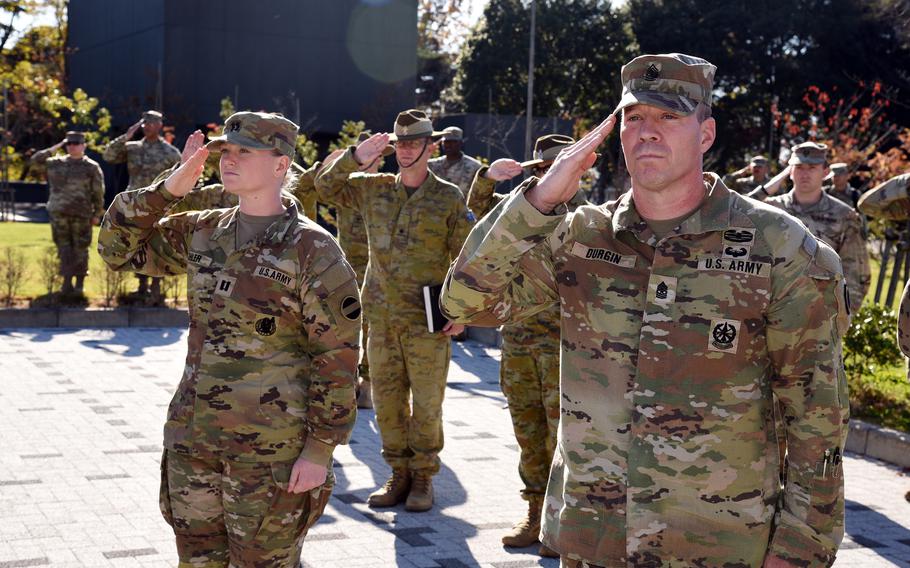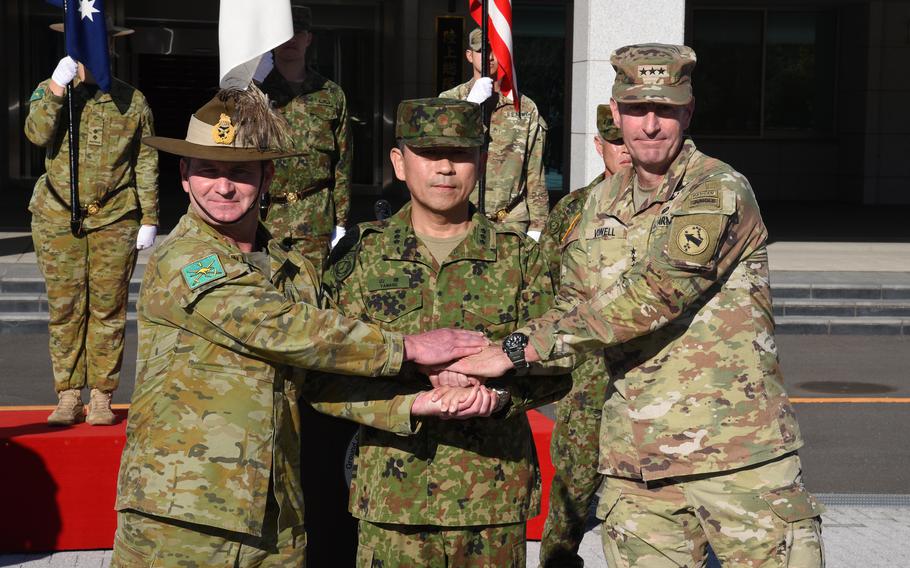
U.S. and Australian troops attend the opening ceremony for the Yama Sakura exercie at Camp Asaka, Japan, Dec. 6, 2024. (Seth Robson/Stars and Stripes)
CAMP ASAKA, Japan — Simulated missile strikes and dispersed military operations are the focus of a nine-day exercise involving forces from the United States, Japan and Australia.
Yama Sakura began Friday at the home of Japan’s Ground Component Command in Saitama prefecture, north of Tokyo, and concludes Dec. 14.
The annual drill involves 1,500 U.S. personnel, 5,000 Japanese troops and 300 Australian soldiers at locations across Japan, Alaska, Hawaii and Australia, according to an Army news release Thursday.
It’s the first time U.S. Marines have joined the command post exercise, and the second year Australians have been full participants, the release said.

Australian army Maj. Gen. Ash Collingburn, Japan Ground Self-Defense Force Lt. Gen. Toshikazu Yamane and U.S. Army Lt. Gen. Joel Vowell pose during the opening ceremony for the Yama Sakura exercise at Camp Asaka, Japan, Dec. 6, 2024. (Seth Robson/Stars and Stripes)
A command post exercise gauges the participants’ ability to manage and respond to a simulated crisis. It typically involves commanders, command staff and communications between participating headquarters.
“We have seen drastic changes in the global power balance,” Lt. Gen. Toshikazu Yamane, commander of Japan’s Ground Component Command, told a formation of troops from the three nations gathered at his home base to start the drill.
He called attention to the conflicts in Ukraine and Gaza and told the troops that Yama Sakura will hone their ability to respond to a crisis and deter adversaries in the region.
This year’s exercise will focus on operations across the land, air, sea, space and cyber domains as well as expeditionary advanced basing, a strategy that involves fighting from dispersed positions that are harder for the enemy to target, Yamane said.
American units involved include the 25th Infantry Division, 11th Airborne Division, 5th Security Force Assistance Brigade, U.S. Army Japan and III Marine Expeditionary Force, according to the Army news release.
Lt. Gen. Joel Vowell, deputy commander U.S. Army Pacific and a former U.S. Army Japan commander, told journalists that participating forces will simulate attacks using precision fires.
One weapon the troops are practicing to use is the precision strike missile, or PrSM, he said, emphasizing that strikes will be simulated.
This summer, the Army helped sink a target ship during the Valiant Shield exercise by launching two of the new missiles from Palau, Naval News reported June 23.
PrSM is capable of neutralizing targets at standoffs greater than 250 miles, according to manufacturer Lockheed Martin.
Australian troops participating in Yama Sakura will also practice employing long-range missiles, Maj. Gen. Ash Collingburn, commander of the Australian Army’s Brisbane-based 1st Division, told the reporters.
The exercise will test long-duration intelligence, surveillance and reconnaissance equipment that can identify enemy targets, Vowell said.
Troops are also using advanced commercial communication gear with a large amount of bandwidth, he said.
“We have speed of information advantage,” he said. “We see sense and understand faster than our adversaries.”